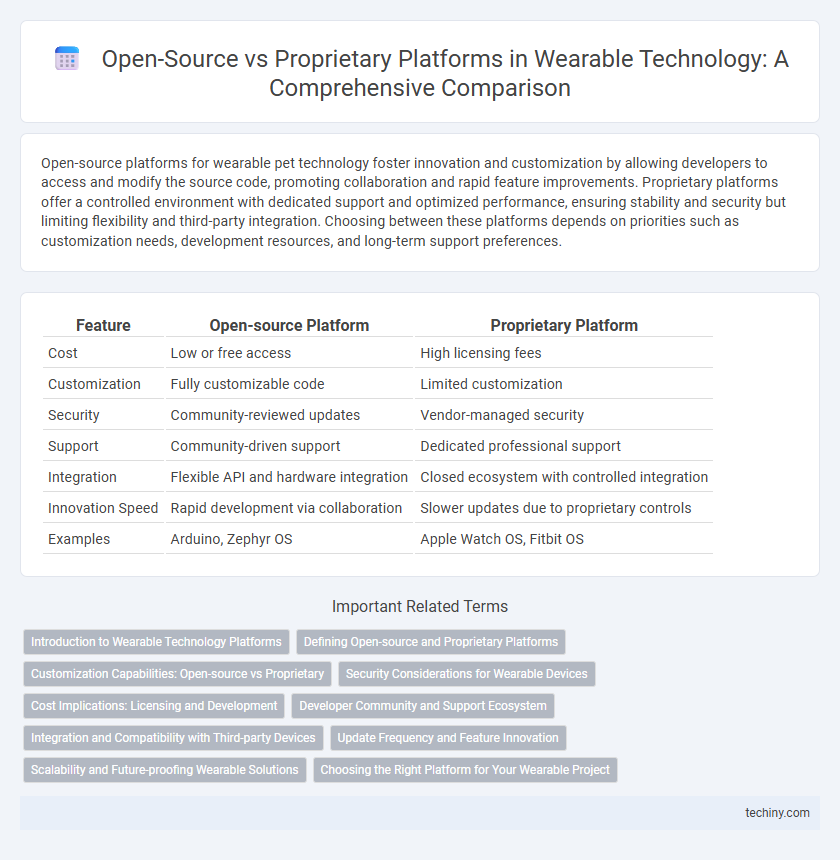Open-source platforms for wearable pet technology foster innovation and customization by allowing developers to access and modify the source code, promoting collaboration and rapid feature improvements. Proprietary platforms offer a controlled environment with dedicated support and optimized performance, ensuring stability and security but limiting flexibility and third-party integration. Choosing between these platforms depends on priorities such as customization needs, development resources, and long-term support preferences.
Table of Comparison
| Feature | Open-source Platform | Proprietary Platform |
|---|---|---|
| Cost | Low or free access | High licensing fees |
| Customization | Fully customizable code | Limited customization |
| Security | Community-reviewed updates | Vendor-managed security |
| Support | Community-driven support | Dedicated professional support |
| Integration | Flexible API and hardware integration | Closed ecosystem with controlled integration |
| Innovation Speed | Rapid development via collaboration | Slower updates due to proprietary controls |
| Examples | Arduino, Zephyr OS | Apple Watch OS, Fitbit OS |
Introduction to Wearable Technology Platforms
Wearable technology platforms serve as the foundational software environments that enable device functionality and application development. Open-source platforms offer customizable, community-driven solutions that foster innovation and rapid prototyping, while proprietary platforms provide controlled ecosystems ensuring optimized performance and security. Key examples include Google's Wear OS as a proprietary option and AsteroidOS as an open-source alternative, both shaping the landscape of wearable device capabilities.
Defining Open-source and Proprietary Platforms
Open-source platforms in wearable technology offer publicly accessible source code, enabling developers to customize, enhance, and share software freely, fostering innovation and collaboration. Proprietary platforms restrict access to source code, maintaining exclusive control by companies to ensure security, consistency, and monetization through licensed usage. These fundamental differences impact software flexibility, development speed, and user experience within wearable ecosystems.
Customization Capabilities: Open-source vs Proprietary
Open-source platforms offer extensive customization capabilities, allowing developers to modify source code and adapt wearable technology to specific user needs or integrate unique functionalities. Proprietary platforms typically restrict access to the underlying code, limiting customization to predefined settings and features controlled by the vendor. This distinction affects user experience, innovation potential, and compatibility with third-party applications in wearable technology ecosystems.
Security Considerations for Wearable Devices
Open-source platforms for wearable technology offer transparent codebases that allow for continuous security auditing by a global community, potentially identifying vulnerabilities faster than proprietary systems. Proprietary platforms provide controlled environments with dedicated security teams, yet their closed-source nature can obscure hidden vulnerabilities from external scrutiny. Ensuring robust encryption, secure firmware updates, and stringent data privacy measures is crucial across both platform types to safeguard sensitive user information in wearable devices.
Cost Implications: Licensing and Development
Open-source platforms for wearable technology significantly reduce licensing costs by offering free access to code, enabling developers to customize and innovate without paying hefty fees. Proprietary platforms often require expensive licenses and ongoing fees, increasing the total cost of ownership and limiting flexibility in software development. Development expenses can be lower on open-source platforms due to community-driven support and resources, whereas proprietary platforms may demand higher costs for specialized tools and vendor-specific expertise.
Developer Community and Support Ecosystem
Open-source wearable technology platforms foster robust developer communities by enabling collaborative innovation, transparent code access, and shared resources, which accelerates feature enhancements and bug fixes. Proprietary platforms offer centralized support ecosystems with dedicated resources, controlled updates, and integrated hardware-software optimization, but often limit third-party customization and slower community-driven development. The choice between open-source and proprietary platforms significantly impacts developer engagement, innovation velocity, and ecosystem scalability in wearable technology.
Integration and Compatibility with Third-party Devices
Open-source platforms in wearable technology offer superior integration and compatibility with third-party devices due to their transparent codebase and community-driven development, enabling seamless customization and interoperability. Proprietary platforms often face limitations in device compatibility as they restrict access to their software development kits (SDKs) and APIs, hindering cross-platform functionality. This distinction significantly impacts the flexibility and scalability of wearable ecosystems, influencing user experience and device adoption rates.
Update Frequency and Feature Innovation
Open-source wearable technology platforms benefit from frequent updates driven by a global community, enabling rapid integration of cutting-edge features and customization options. Proprietary platforms often have slower update cycles constrained by internal development teams, limiting immediate access to new innovations. This dynamic results in open-source platforms typically leading in timely feature enhancements and responsiveness to user feedback.
Scalability and Future-proofing Wearable Solutions
Open-source platforms in wearable technology offer unparalleled scalability through community-driven development, enabling rapid integration of new features and adaptation to emerging standards. Proprietary platforms, while often providing optimized performance and dedicated support, may face limitations in future-proofing due to restricted access to source code and slower innovation cycles. Selecting an open-source platform enhances long-term sustainability and flexibility, critical for evolving wearable solutions in dynamic markets.
Choosing the Right Platform for Your Wearable Project
Selecting the right platform for a wearable technology project depends on factors such as customization needs, development cost, and community support. Open-source platforms offer flexibility, extensive developer communities, and cost-effectiveness, enabling tailored solutions and rapid innovation. Proprietary platforms provide robust security, dedicated customer support, and optimized performance, making them ideal for commercial products requiring stability and compliance.
Open-source Platform vs Proprietary Platform Infographic

 techiny.com
techiny.com